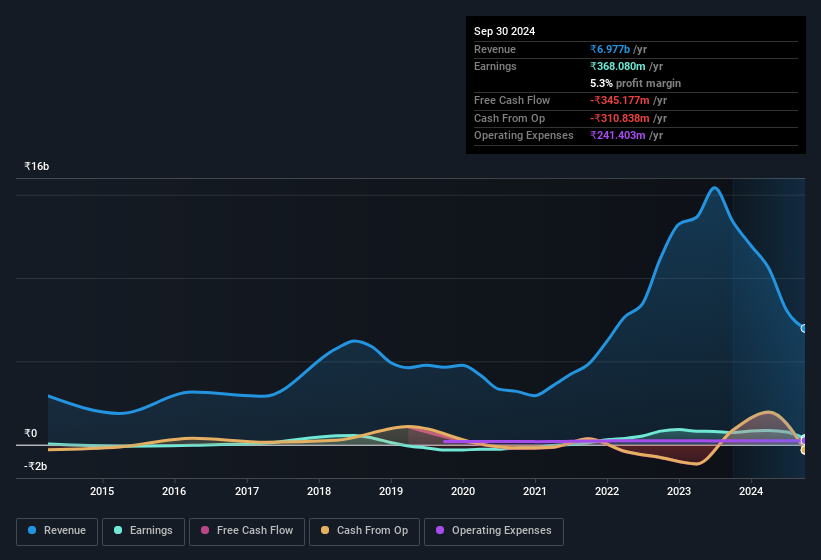- India
- /
- Metals and Mining
- /
- NSEI:GOACARBON
Weak Statutory Earnings May Not Tell The Whole Story For Goa Carbon (NSE:GOACARBON)
Investors were disappointed by Goa Carbon Limited's (NSE:GOACARBON ) latest earnings release. Our analysis has found some reasons to be concerned, beyond the weak headline numbers.
Check out our latest analysis for Goa Carbon

Examining Cashflow Against Goa Carbon's Earnings
In high finance, the key ratio used to measure how well a company converts reported profits into free cash flow (FCF) is the accrual ratio (from cashflow). In plain english, this ratio subtracts FCF from net profit, and divides that number by the company's average operating assets over that period. This ratio tells us how much of a company's profit is not backed by free cashflow.
That means a negative accrual ratio is a good thing, because it shows that the company is bringing in more free cash flow than its profit would suggest. That is not intended to imply we should worry about a positive accrual ratio, but it's worth noting where the accrual ratio is rather high. Notably, there is some academic evidence that suggests that a high accrual ratio is a bad sign for near-term profits, generally speaking.
Goa Carbon has an accrual ratio of 0.23 for the year to September 2024. We can therefore deduce that its free cash flow fell well short of covering its statutory profit. Over the last year it actually had negative free cash flow of ₹345m, in contrast to the aforementioned profit of ₹368.1m. It's worth noting that Goa Carbon generated positive FCF of ₹859m a year ago, so at least they've done it in the past. However, that's not all there is to consider. The accrual ratio is reflecting the impact of unusual items on statutory profit, at least in part. The good news for shareholders is that Goa Carbon's accrual ratio was much better last year, so this year's poor reading might simply be a case of a short term mismatch between profit and FCF. Shareholders should look for improved cashflow relative to profit in the current year, if that is indeed the case.
Note: we always recommend investors check balance sheet strength. Click here to be taken to our balance sheet analysis of Goa Carbon.
The Impact Of Unusual Items On Profit
Given the accrual ratio, it's not overly surprising that Goa Carbon's profit was boosted by unusual items worth ₹53m in the last twelve months. We can't deny that higher profits generally leave us optimistic, but we'd prefer it if the profit were to be sustainable. When we crunched the numbers on thousands of publicly listed companies, we found that a boost from unusual items in a given year is often not repeated the next year. And that's as you'd expect, given these boosts are described as 'unusual'. If Goa Carbon doesn't see that contribution repeat, then all else being equal we'd expect its profit to drop over the current year.
Our Take On Goa Carbon's Profit Performance
Summing up, Goa Carbon received a nice boost to profit from unusual items, but could not match its paper profit with free cash flow. Considering all this we'd argue Goa Carbon's profits probably give an overly generous impression of its sustainable level of profitability. So while earnings quality is important, it's equally important to consider the risks facing Goa Carbon at this point in time. Our analysis shows 4 warning signs for Goa Carbon (2 are a bit concerning!) and we strongly recommend you look at them before investing.
Our examination of Goa Carbon has focussed on certain factors that can make its earnings look better than they are. And, on that basis, we are somewhat skeptical. But there is always more to discover if you are capable of focussing your mind on minutiae. For example, many people consider a high return on equity as an indication of favorable business economics, while others like to 'follow the money' and search out stocks that insiders are buying. So you may wish to see this free collection of companies boasting high return on equity, or this list of stocks with high insider ownership.
New: Manage All Your Stock Portfolios in One Place
We've created the ultimate portfolio companion for stock investors, and it's free.
• Connect an unlimited number of Portfolios and see your total in one currency
• Be alerted to new Warning Signs or Risks via email or mobile
• Track the Fair Value of your stocks
Have feedback on this article? Concerned about the content? Get in touch with us directly. Alternatively, email editorial-team (at) simplywallst.com.
This article by Simply Wall St is general in nature. We provide commentary based on historical data and analyst forecasts only using an unbiased methodology and our articles are not intended to be financial advice. It does not constitute a recommendation to buy or sell any stock, and does not take account of your objectives, or your financial situation. We aim to bring you long-term focused analysis driven by fundamental data. Note that our analysis may not factor in the latest price-sensitive company announcements or qualitative material. Simply Wall St has no position in any stocks mentioned.
About NSEI:GOACARBON
Goa Carbon
Manufactures, markets, and sells calcined petroleum coke in India.
Slightly overvalued with imperfect balance sheet.
Similar Companies
Market Insights
Community Narratives




